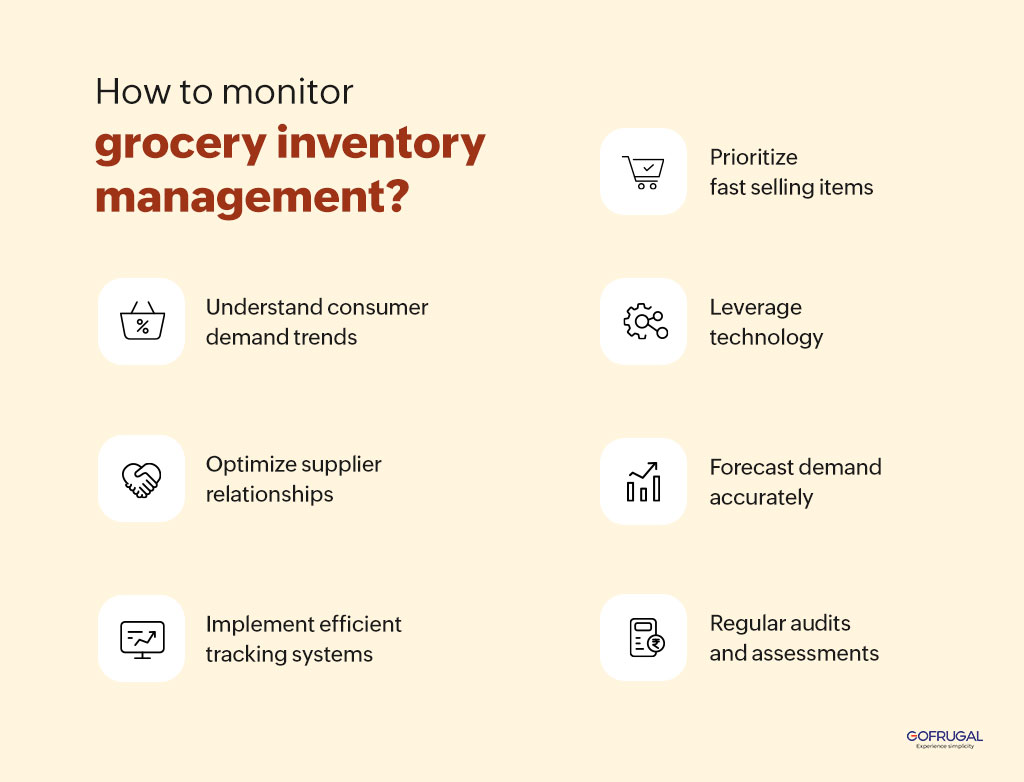Key takeaways:
- Discover how grocery inventory management ensures accurate stock tracking, waste reduction, and optimized product placement for both in-store and online orders.
- Learn how effective inventory control prevents stockouts, balances costs, and enhances both customer satisfaction and profitability.
- Explore how Gofrugal’s software provides real-time analytics, shelf-life tracking, and barcode integration to streamline grocery operations and support business growth.
Contents
- What is grocery inventory management?
- Why is effective inventory management important for grocery stores?
- Grocery store inventory management process
- How do different types of grocery stores manage inventory?
- Challenges in grocery store inventory management
- How to monitor grocery inventory management
- Importance of grocery inventory management software
What is grocery inventory management?
Grocery store inventory management involves tracking every item’s quantity, value, and location within a store using technologies like barcodes. Unlike other retailers, you need dynamic inventory control that manages both physical stores and online orders. They also handle separate inventories for prepared foods and innovate by repurposing unsold items to maintain profit margins emphasizing the importance of grocery inventory management.
Why is effective inventory management important for grocery stores?
- Keep your shelves stocked with the right items, minimizing empty spaces and ensuring a pleasant shopping experience for customers.
- Prevent stockouts by having the right products available, making sure customers can find what they need when they visit your store, highlighting the significance of supermarket stock management.
- Maintain a balance in your inventory to optimize spending, reducing overstocking that ties up funds and potential waste due to expired items.
- Manage stock levels smartly to save money by not overbuying or losing products to expiration, indicating the importance of grocery inventory management.
Grocery store inventory management process
- Sourcing from suppliers: Select products based on what customers prefer and what’s been popular before.
- Quality checks: Upon delivery, items are carefully inspected to ensure they’re in top condition before being placed on shelves, indicating the significance of supermarket inventory management.
- Strategic shelf organization: Products are organized neatly on shelves, making it easy for customers to find what they need, highlighting the importance of the grocery store inventory management system.
- Precise inventory tracking: Using systems like barcoding, you can track sales and stock positions, ensuring everything is available for shoppers.
- Reordering: When stocks dip low, orders are swiftly placed to restock shelves, much like refilling household supplies.
- Restocking: Shelves are regularly refilled from storage to keep the store fully stocked and ready for customers.
How do different types of grocery stores manage inventory?
Physical grocery inventory management
- Real-time POS tracking: Grocery stores rely on specialized inventory management software for seamless point of sale (POS) tracking, underlining the importance of grocery store inventory management. When items are scanned at checkout, they’re instantly deducted from the inventory count, maintaining precise stock levels in real time.
- In-store inventory management: Advanced grocery inventory systems help manage shelf restocking and layout optimization using data from POS systems, showcasing the significance of grocery store inventory management systems. These systems identify fast-moving items, preventing overstocking or stockouts, and streamlining in-store operations for a better shopping experience.
- Fulfilment from store inventory: Both in-store purchases and online orders are managed through an integrated grocery inventory system, illustrating the necessity of efficient grocery store inventory management. This system efficiently uses store inventory to fulfil customer demands, whether shopping in-store or online.
Online grocery inventory management
- Fulfillment from store proximity: Online orders are fulfilled from the nearest store, reducing delivery times using specialized grocery store inventory management software. Inventory systems reserve items specifically for online orders, preventing overselling and ensuring items are available for online shoppers.
- Dynamic stock on hand (SOH): For online orders, items are temporarily held in a “stock on hand” status until the order is completed. This method ensures accurate availability for other online shoppers by reserving items until they’re purchased, , stressing the importance of grocery inventory management.
- Order completion updates: Grocery inventory systems update in real time as online orders are packed and leave the store. Any substitutions or unpicked items are recorded, maintaining inventory accuracy, demonstrating the significance of grocery store inventory management software.
The key difference lies in the fulfillment and tracking mechanisms. Physical stores leverage specialized grocery inventory management software and in-store systems for immediate tracking and restocking. On the other hand, online stores operate with systems that prioritize efficient order fulfillment from nearby stores and maintain dynamic inventory statuses to meet online demand while ensuring real-time updates and accuracy in inventory levels.
Challenges in grocery store inventory management
Consumer-driven challenges:
- Fluctuating consumer needs due to changing seasons, trends, or market shifts.
- Understanding local customer preferences and buying patterns to align inventory.
Supply-related challenges:
- Issues like delays, transportation problems, or supplier shortages affect stock levels.
- Coordinating with multiple suppliers for timely deliveries and quality products.
Inventory management challenges:
- Handling freshness and shelf life of perishables effectively.
- Managing numerous product variations while avoiding overstocking or stockouts.
Location challenges:
- Limited space, especially in urban settings, for stocking diverse products without overcrowding.
How to monitor grocery inventory management
Understand consumer demand trends: Stay updated on customer preferences, seasonal shifts, and market trends to fine-tune your grocery store inventory management strategies.
Prioritize fast-selling items: Keep a sharp eye on top-selling products, ensuring their consistent availability with efficient grocery inventory systems.
Optimize supplier relationships: Cultivate strong ties with reliable suppliers. Timely communication and mutually beneficial terms ensure a consistent inventory supply.
Leverage technology: Utilize advanced grocery store inventory management software for seamless monitoring and real-time data analysis, tailored to your business needs.
Implement efficient tracking systems: Utilize barcode technology to track stock movement accurately. Such systems enhance inventory control and reduce errors.
Forecast demand accurately: Analyze historical data to predict future demand. This helps avoid overstocking or stockouts, ensuring a balanced inventory.
Regular audits and assessments: Conduct routine checks to assess inventory levels, identify slow-moving stock, and evaluate storage conditions. This aids in preventing waste and optimizing storage space.
Importance of grocery inventory management software
Efficient grocery inventory management software, such as Gofrugal, plays a vital role in modern grocery store inventory management. Real-time analytics help you swiftly adapt inventory to shifting customer needs and market trends, addressing challenges in grocery store inventory management system. This software ensures product freshness with shelf life tracking, minimizing waste, too, while barcode integration streamlines operations, ensuring precise control over grocery inventory systems. It also fosters strong supplier relationships, ensuring reliable supplies for uninterrupted grocery store inventory management.
More so, grocery inventory management software helps you understand customer preferences to guide inventory decisions, enhancing satisfaction. Integrated sales channels offer a seamless shopping experience, ensuring consistency, too. Analytics dashboards provide crucial insights into product performance, aiding informed decisions for optimized stock levels and reduced waste in inventory management software for grocery stores.
Are you ready to grow with confidence?
Gofrugal’s inventory software serves as your store’s compass, steering you through fluctuations with real-time insights, precise shelf-life tracking, and seamless barcode integration. Its multichannel sales unify your operations for smoother sailing. Pair up with Gofrugal for efficient inventory management and a prosperous retail journey.


